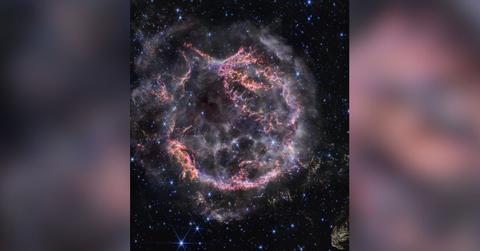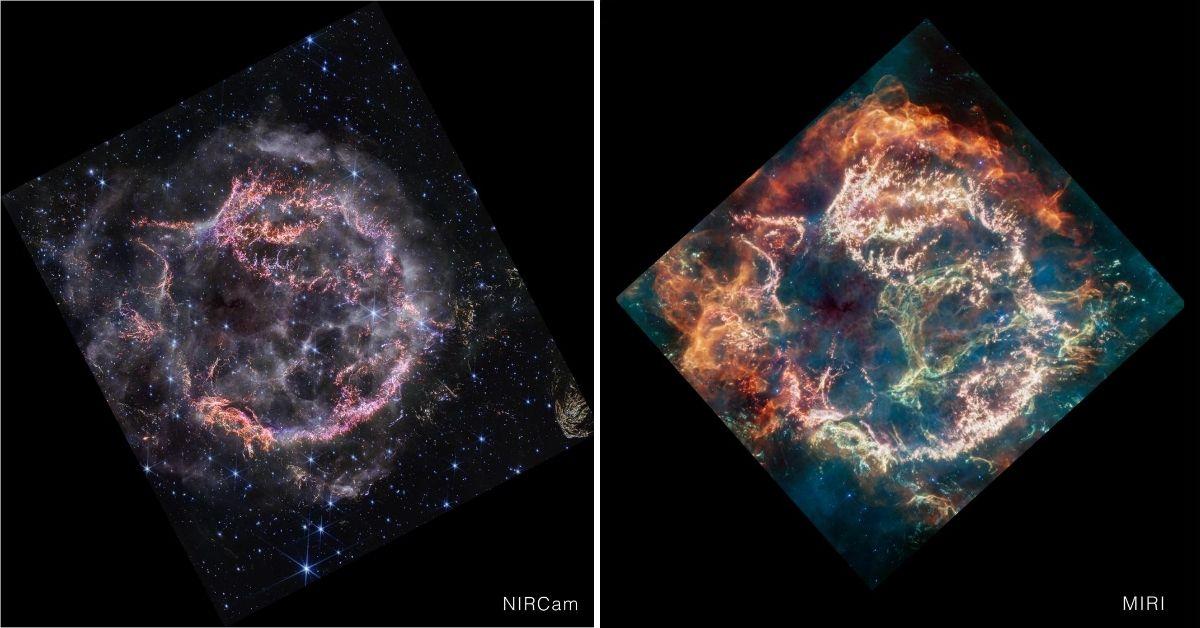Blast from the Past: NASA Telescope Captures Vivid Image of Cosmic Fallout From Star That Exploded 3 Centuries Ago

NASA's James Webb Space Telescope captured a new image showing the remnants of a star named Cassiopeia A, or "Cas A," that exploded about 340 years ago.
Dec. 13 2023, Published 11:02 a.m. ET
NASA has unveiled an awe-inspiring depiction of the cosmic aftermath following the explosion of a star.
The James Webb Space Telescope (JWST) captured the remnants of the supernova, known as Cassiopeia A or "Cas A," were captured in vivid detail. The image, shot by the telescope's near-infrared camera (NIRCam), portrays fragments of dispersed material forming an expanding shell resulting following the star's demise, NASA reported recently.

This side-by-side comparison shows images of Cassiopeia A captured by NASA's James Webb Space Telescope's near-infrared camera (NIRCam) and mid-infrared instrument (MIRI).
Located a relatively short 11,000 lightyears away from Earth in the Cassiopeia constellation, Cas A exploded approximately 340 years ago, according to NASA.
Despite extensive studies by astronomers using various telescopes, the JWST's images have produced both new and unexpected features within the supernova remnant's inner shell.
The colors captured in the NIRCam image accentuate vivid clusters of bright orange and pink of the inner shell, showcasing sulfur, oxygen, argon and neon remnants from within the supernova.
Dust particles and molecules destined to play a role in the formation of future stars and planetary systems are embedded within this gaseous composition, NASA reported.
- Deep-Space Discovery: Powerful NASA Telescope Locates 'Ghostly' Remote Galaxy Enveloped in Cosmic Dust Clouds
- Stellar Discovery: James Webb Telescope Detects Possibly Earliest Stars in the Known Universe
- Astronomers Dub Repeated Bright Flares From Exploded Star's 'Stellar Corpse' as the 'Tasmanian Devil'
These tiny "knots of gas" — discernible only because of the NIRCam — provide new insights into the events that unfolded when Cas A exploded.
“With NIRCam’s resolution, we can now see how the dying star absolutely shattered when it exploded, leaving filaments akin to tiny shards of glass behind," Danny Milisavljevic of Purdue University, who led the research team capturing the new images, explains. "It’s really unbelievable after all these years studying Cas A to now resolve those details, which are providing us with transformational insight into how this star exploded.”
In April of 2023, the JWST's mid-infrared instrument (MIRI) uncovered unexpected features within the inner shell of the supernova remnant, many of which remain invisible in the new NIRCam image.
The outskirts of Cas A’s primary inner shell, appearing as deep orange and red in the MIRI image, is portrayed as gray wisps in the NIRCam image. NASA attributes this distinction to the fact that the dust resulting from the explosion was too cool to be detected at near-infrared wavelengths but became visible in the mid-infrared.
Never miss a story — sign up for the Front Page Detectives newsletter. Be on the scene the moment news breaks.
Notable in the near-infrared view is the absence of the loop of green light in the central cavity of Cas A, known to radiate in mid-infrared and dubbed the "Green Monster" by the research team.
Become a Front Page Detective
Sign up to receive breaking
Front Page Detectives
news and exclusive investigations.
